It’s a bird, it’s a plane…. it’s a….. TWEET?
I admit that my Twitter experience (very little at best) consisted of mainly scrolling through celebrity feuds (a la the Twitter argument between Taylor Swift, Nicki Minaj and Katy Perry) and gossip to keep up with the latest Hollywood news. I never considered the 140 character Twitter platform to be utilized so well for public health. Examining a few major public health Twitter accounts, namely UNICEF, CDC, WHO and the CDC Emergency Preparedness and Response, I see now that this is a quick, simple, effective way to deliver a succinct message. There are some main commonalities in how this platform is used as a public health delivery system:
1. Engaging photos: These sites all had color, engaging photos that reflected the goal of their organization. UNICEF and the WHO had photos reflecting public health care in other countries. The CDC showed researchers and healthy families.
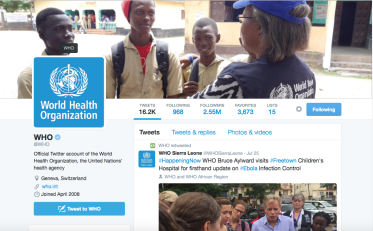

2. Minimal use of #hashtags: 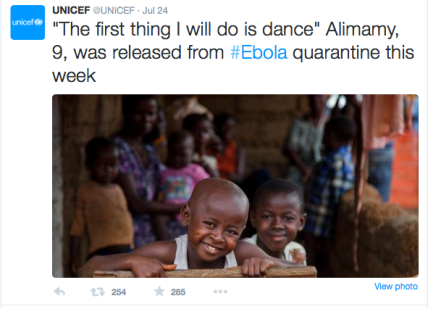 Unlike many other twitter pages that end every post with 20 different hashtags, these public health pages used hashtags minimally, making them more effective.
Unlike many other twitter pages that end every post with 20 different hashtags, these public health pages used hashtags minimally, making them more effective.
1-2 hashtags within the posts that were very relevant and extremely important and noticeable. In these settings, less is more.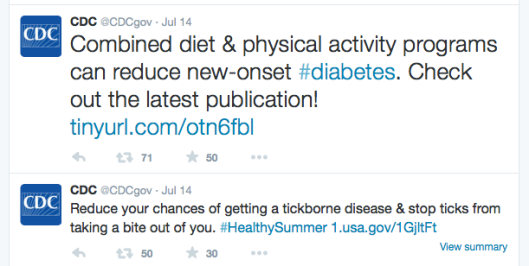
3. Links to outside resources with brief synopsis: 
These pages all had many links to resources such as studies, relevant news stories, and places to get further, reliable information. This is extremely important since it is tough to communicate all
necessary material in 140 characters. However, in our world that is constantly going “faster and faster,” as is illustrated by Shirky’s “Here Comes Everybody,” sending the main idea of a webpage in 140 characters is about what the average reader is looking for these days
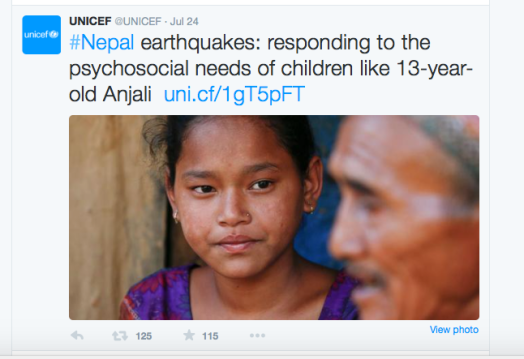
4. Multiple posts a day: Much like the concept of the “Blitzkrieg,” these entities can use this mode of communication as the modern-day radio to deliver quick, repetitive blows to eventually overcome a seemingly bigger opponent. A reoccurring theme on these public health pages is to post multiple times a day on a range of topics in different ways (pictures, stories, links). This allows the most people to receive and process the information while scrolling through their Twitterfeed.
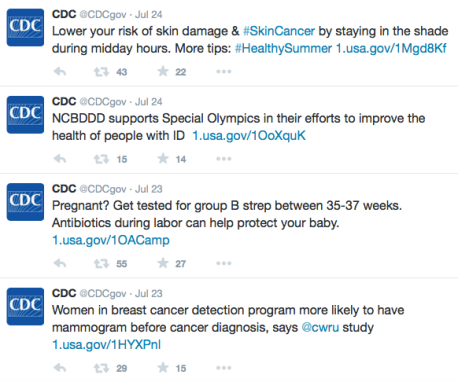

Now let’s all get out there and start tweeting for health!
Resources:
https://twitter.com/CDCemergency
Shirky, Clay “Here Comes Everybody”
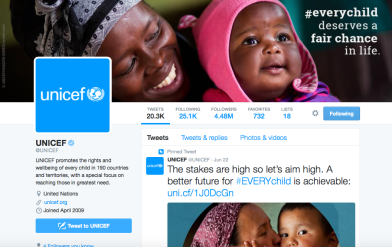
Really nice job with both the content and the formatting of embedded the tweets. I definitely saw the appeal from a public health perspective. The only thing you may have missed was the speed of Twitter – great in an emergency!
Great list and layout. It is nice that you pair each section with a variety of photos to illustrate your point. I particularly like #2. I can’t remember exactly what Social Media for Social Good referred to this as, but they definitely made a point of saying that too many hashtags makes your blog lose credibility and comes off as a hashtag spammer. I agree that less is more for public health pages. #4 is a great point as well. I like how you incorporate the concept of “Blitzkrieg.” It is important to stay relevant since Twitter posts only have a 90 minute life span or so. No one is going to comment on a post made last week. Multiple posts a day definitely helps to emphasize your point and to keep your feed up to date. One small suggestion is to make your concluding paragraph on the left, as it appears it is still part of #4. However, I like the zigzag appearance of your blog layout. Great use of references and incorporating applicable readings into the content.
Agree with Taylor, the layout was great. Kept interest, made the text seem succinct, and gave immediate examples of the issues brought up. Also agree with Taylor about the hashtag count. I find them annoying myself, and hashtag spammer is a brilliant way of putting that. I didn’t notice on the health blogs they had less hashtags, that was a good pick up. Maybe that’s why I didn’t mind the health microblogs as much!
I liked your post. I thought the images were really engaging and you used them well to support the content of your post. Your paragraphs were just the right length and there weren’t any large blocks of text likely to loose readers.
One suggestion for future, you might consider adding the links such as those listed at the end of the post, to the images themselves. Clicking the image would then directly take you to the site.
Nice job.
Great post Melissa!
I love the staggered images and text at different heights and alignments. The layout was visually interesting – I felt like I was watching and reading a puzzle almost, in a great way, my eyes flicked across from image to text and back and seeing how they fit together.
You used really great and attention grabbing images.
I also loved you engaging and relaxed language, really relate-able.
Great post!
I really liked structure and formatting of this blog, its vivid engaging images to support messages. I found useful CDC Tweet example in #4 bullet: generous amount of tweets related to diverse topics expressed in very simple format without overwhelming followers by hashtags and Twitter usernames. These are perfect examples for new public health Twitters!